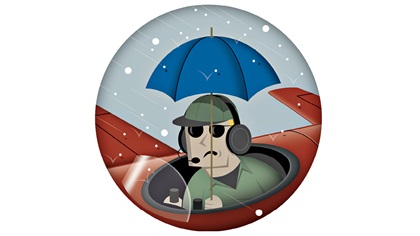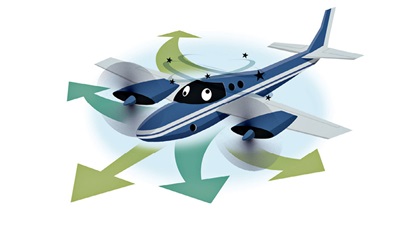 Checkride-ready
Checkride-ready
See how you measure up to FAA standards with these questions from the AOPA Pilot Information Center.
- When taking off or landing at an airport where heavy aircraft are operating, one should be particularly alert to the hazards of wingtip vortices because this turbulence tends to
A. sink into the flight path of aircraft operating below the aircraft generating the turbulence.
B. rise into the traffic pattern area surrounding the airport.
C. rise from a crossing runway into the takeoff or landing path. - An air traffic control clearance provides
A. authorization to proceed under specified traffic conditions in controlled airspace.
B. adequate separation from all traffic.
C. priority over all other traffic. - What are the standard temperature and pressure values for sea level?
A. 59 degrees F and 29.92 millibars.
B. 59 degrees C and 1013.2 millibars.
C. 15 degrees C and 29.92 inches Hg. - Which weather phenomenon is always associated with a thunderstorm?
A. Lightning.
B. Heavy rain.
C. Hail. - In the Northern Hemisphere, the magnetic compass will normally indicate a turn toward the south when
A. a left turn is entered from an east heading.
B. the aircraft is decelerated while on a west heading.
C. a right turn is entered from a west heading.
 Ace
Ace
Can you correctly answer these questions from retired TWA captain and 28,000-hour pilot Barry Schiff?
- True or false? Hail is one possible danger associated with flight over a large wildfire.
- Which of the following does not belong?
A. Accelerated.
B. Departure.
C. Hammerhead.
D. Whip. - True or false? A VFR pilot is in straight and level flight at 5,500 feet msl. Her magnetic course, therefore, should be between 000 and 179 degrees.
- A VFR pilot is in cruise flight beneath a flat, level overcast and is observing cloud-clearance requirements. There are no clouds at or below his altitude. He begins a descent that almost immediately causes him to violate cloud-clearance requirements. How is this possible?
- Which of the following does not belong?
A. Fowler.
B. Friese.
C. Slotted.
D. Split.
E. Zap.
Final Exam Answers
- The answer is A. Wingtip vortices always spread out, sink, and eventually dissipate. Wingtip vortices are greatest when the generating aircraft is heavy, clean, and slow. This condition is most commonly encountered during approaches or departures because an aircraft’s angle of attack is at the highest to produce the lift necessary to land or take off. (Pilot’s Handbook of Aeronautical Knowledge, Chapter 5)
- The answer is A. ATC cannot see all air traffic, and only an emergency mayday call gives one priority over other traffic. Accordingly, an ATC clearance is permission or an authorization to proceed as instructed while in controlled airspace, for the purpose of preventing collisions between known aircraft. (Aeronautical Information Manual 4-4-1)
- The answer is C. Standard day conditions are 15 degrees C/59 degrees F and 29.92 inches/1013.2 millibars. The temperature drops about 2 degrees C/3.5 degrees F per 1,000 feet of altitude gain, and the pressure drops about 1 inch/34 mb per 1,000 feet gain in altitude, up to about 10,000 feet. (Pilot’s Handbook of Aeronautical Knowledge, Chapter 4)
- The answer is A. Of course, you remember this from elementary school. In order to have thunder, there must first be lightning. Heavy rain is common, but not always present depending on the storm’s size. Hail reaching the surface is sometimes seen, but is rather rare with many thunderstorms. (Pilot’s Handbook of Aeronautical Knowledge, Chapter 12)
- The answer is B. Remember ANDS—accelerate north, decelerate south. While accelerating on an easterly or westerly heading, the compass will initially indicate a turn to the north. Conversely, the compass will initially show a turn to the south while decelerating on those headings. (Pilot’s Handbook of Aeronautical Knowledge, Chapter 8)
- True. Fire-induced atmospheric moisture and convection can produce large thunderstorms—colloquially known as pyrocumulus—over the fire. Unfortunately, these cells usually drift downwind and do not contribute to extinguishing the fire.
- The answer is C. The others are types of stalls. The hammerhead turn is occasionally and incorrectly called a hammerhead stall, but the wings do not stall during this aerobatic maneuver (even though the British call it a stall turn).
- False. This is true only when cruising at more than 3,000 feet above the surface. When at or below 3,000 feet agl—irrespective of the altitude above sea level—a VFR pilot may cruise at any altitude.
- The pilot descends through the floor of Class B
airspace where he has been flying only 100 feet beneath the overcast. (He is required only to remain clear of clouds when in Class B airspace.) He then descends into Class E airspace where he suddenly is required to be 500 feet beneath that same overcast. - The answer is B. The others are types of flaps. The Friese aileron was designed to reduce adverse yaw effect. When the Friese aileron moves up, a lip on the leading edge of the aileron extends beneath the bottom surface of the wing and increases drag on that wing to closely match the drag created by the lowered aileron on the opposite wing.
Related Articles
Pilot Protection Services


